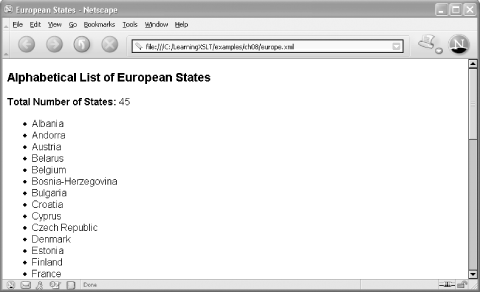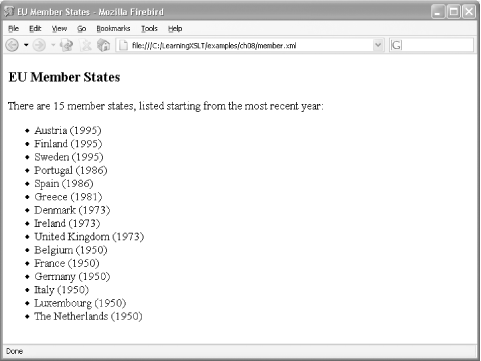Chapter 8. Sorting Things Out
Sometimes nodes don’t come to you in a convenient
order. XSLT’s sort
instruction element allows you to sort
nodes in alphabetical or numerical order. You can also use
sort to sort nodes in ascending
(a, b,
c) or descending (z,
y, x) order.
This chapter walks you through a brief exploration of
sort. You can also read about sorting in Section
10 of the XSLT specification. I’ll start, as usual,
with a simple example.
Simple Ascending Sort
If you look at Example 8-1, the document europe.xml in examples/ch08, you’ll notice that the European states are not listed in alphabetical order.
<?xml version="1.0" encoding="UTF-8"?> <?xml-stylesheet href="pretty.xsl" type="text/xsl"?> <europe> <state>Belgium</state> <state>Germany</state> <state>Finland</state> <state>Greece</state> <state>Ireland</state> <state>Luxembourg</state> <state>Portugal</state> <state>Spain</state> <state>Andorra</state> <state>Belarus</state> <state>Monaco</state> <state>Sweden</state> <state>United Kingdom</state> <state>Austria</state> <state>Malta</state> <state>Vatican City</state> <state>Bulgaria</state> <state>Bosnia-Herzegovina</state> <state>Cyprus</state> <state>France</state> <state>Estonia</state> <state>Italy</state> <state>Hungary</state> <state>Latvia</state> <state>Ukraine</state> <state>Lithuania</state> <state>Moldova</state> <state>Denmark</state> <state>Poland</state> <state>Romania</state> <state>Slovenia</state> <state>The Netherlands</state> <state>Turkey</state> <state>Albania</state> <state>Serbia and Montenegro</state> <state>Croatia</state> <state>Slovakia</state> <state>Iceland</state> <state>Czech Republic</state> <state>Liechtenstein</state> <state>Macedonia, Former Yugoslav Republic of</state> <state>Norway</state> <state>Russia</state> <state>San Marino</state> <state>Switzerland</state> </europe>
You can sort the names of the European states in ascending order
(that is, in English as a,
b, c, and so on) by using
the sort element with no attributes, as a child of
apply-templates.
The sort element is used in the stylesheet shown
in Example 8-2,
sort.xsl
.
<xsl:stylesheet version="1.0" xmlns:xsl="http://www.w3.org/1999/XSL/Transform">
<xsl:output method="text"/>
<xsl:template match="europe">
<xsl:text>Alphabetical List of European States</xsl:text>
<xsl:text> Total Number of States: </xsl:text>
<xsl:value-of select="count(state)"/>
<xsl:text> </xsl:text>
<xsl:apply-templates select="state">
<xsl:sort/>
</xsl:apply-templates>
</xsl:template>
<xsl:template match="state">
<xsl:text> - </xsl:text>
<xsl:apply-templates/>
<xsl:text> </xsl:text>
</xsl:template>
</xsl:stylesheet>This stylesheet produces plain text output (it uses the text method
of output), as shown in Example 8-3. A few
text instruction elements are sprinkled here and
there to label the output or add a line feed (using the
character reference). The
count( ) function is also used to count the number
of state elements in the source tree, and the
return value of this function is displayed using
value-of.
The sort
element appears as a child of
apply-templates
. It may only appear as a child of either
apply-templates or for-each.
Tip
The XSLT instruction element for-each is like a
template within a template that selects a node-set and then
instantiates its template for each node in the set. You will see this
element demonstrated in several places in this book.
In this stylesheet, when state elements are
selected with apply-templates, the processor will
also apply a sort.
To see what happens, apply the sort.xsl stylesheet to europe.xml using this command:
xalan europe.xsl sort.xsl
The plain text, alphabetized result tree shown in Example 8-3 will be output to your screen.
Alphabetical List of European States Total Number of States: 45 - Albania - Andorra - Austria - Belarus - Belgium - Bosnia-Herzegovina - Bulgaria - Croatia - Cyprus - Czech Republic - Denmark - Estonia - Finland - France - Germany - Greece - Hungary - Iceland - Ireland - Italy - Latvia - Liechtenstein - Lithuania - Luxembourg - Macedonia, Former Yugoslav Republic of - Malta - Moldova - Monaco - Norway - Poland - Portugal - Romania - Russia - San Marino - Serbia and Montenegro - Slovakia - Slovenia - Spain - Sweden - Switzerland - The Netherlands - Turkey - Ukraine - United Kingdom - Vatican City
If you would like pretty output worthy of a browser, you could also create an HTML wrapper with the stylesheet shown in Example 8-4, pretty.xsl .
<xsl:stylesheet version="1.0" xmlns:xsl="http://www.w3.org/1999/XSL/Transform">
<xsl:template match="europe">
<html>
<head><title>European States</title></head>
<style type="text/css">body {font-family: sans-serif}</style>
<body>
<h3>Alphabetical List of European States</h3>
<p><b>Total Number of States:</b><xsl:text> </xsl:text>
<xsl:value-of select="count(state)"/></p>
<ul>
<xsl:apply-templates select="state">
<xsl:sort/>
</xsl:apply-templates>
</ul>
</body>
</html>
</xsl:template>
<xsl:template match="state">
<li><xsl:apply-templates/></li>
</xsl:template>
</xsl:stylesheet>This stylesheet produces indented HTML output by default (without
explicitly stating so in an output element),
because the first element in the result tree is
html and there is no output
element to define the method.
Process the stylesheet with Xalan:
xalan -i 1 europe.xml pretty.xsl
Once again, the -i option followed by
1 tells the processor to indent the output by one
space. You will see output like Example 8-5.
<html>
<head>
<META http-equiv="Content-Type" content="text/html; charset=UTF-8">
<title>European States</title>
</head>
<style type="text/css">body {font-family: sans-serif}</style>
<body>
<h3>Alphabetical List of European States</h3>
<p>
<b>Total Number of States:</b> 45</p>
<ul>
<li>Albania</li>
<li>Andorra</li>
<li>Austria</li>
<li>Belarus</li>
<li>Belgium</li>
<li>Bosnia-Herzegovina</li>
<li>Bulgaria</li>
<li>Croatia</li>
<li>Cyprus</li>
<li>Czech Republic</li>
<li>Denmark</li>
<li>Estonia</li>
<li>Finland</li>
<li>France</li>
<li>Germany</li>
<li>Greece</li>
<li>Hungary</li>
<li>Iceland</li>
<li>Ireland</li>
<li>Italy</li>
<li>Latvia</li>
<li>Liechtenstein</li>
<li>Lithuania</li>
<li>Luxembourg</li>
<li>Macedonia, Former Yugoslav Republic of</li>
<li>Malta</li>
<li>Moldova</li>
<li>Monaco</li>
<li>Norway</li>
<li>Poland</li>
<li>Portugal</li>
<li>Romania</li>
<li>Russia</li>
<li>San Marino</li>
<li>Serbia and Montenegro</li>
<li>Slovakia</li>
<li>Slovenia</li>
<li>Spain</li>
<li>Sweden</li>
<li>Switzerland</li>
<li>The Netherlands</li>
<li>Turkey</li>
<li>Ukraine</li>
<li>United Kingdom</li>
<li>Vatican City</li>
</ul>
</body>
</html>If you simply open europe.xml with a browser such as Netscape 7.1, the browser will apply the stylesheet pretty.xsl referenced in the XML stylesheet PI, and the result will appear in the browser as shown in Figure 8-1.
Reversing the Sort
The sort element uses
ascending order by default, as if the order
attribute were present with a value of ascending,
like so:
<xsl:sort order="ascending"/>
This order follows the normal a,
b, c order of the English
alphabet. You can also sort in descending order, that is, using
English, in the order z, y,
x. To do this, you have to add an
order attribute to
sort
,
as does the stylesheet descending.xsl, shown in
Example 8-6.
<xsl:stylesheet version="1.0" xmlns:xsl="http://www.w3.org/1999/XSL/Transform">
<xsl:output method="text"/>
<xsl:template match="europe">
<xsl:apply-templates select="state">
<xsl:sort order="descending"/>
</xsl:apply-templates>
<xsl:text>Number of European States: </xsl:text>
<xsl:value-of select="count(state)"/>
<xsl:text> </xsl:text>
</xsl:template>
<xsl:template match="state">
<xsl:text> - </xsl:text>
<xsl:apply-templates/>
<xsl:text> </xsl:text>
</xsl:template>
</xsl:stylesheet>Now apply it with:
xalan europe.xml descending.xsl
to get the output shown in Example 8-7.
- Vatican City - United Kingdom - Ukraine - Turkey - The Netherlands - Switzerland - Sweden - Spain - Slovenia - Slovakia - Serbia and Montenegro - San Marino - Russia - Romania - Portugal - Poland - Norway - Monaco - Moldova - Malta - Macedonia, Former Yugoslav Republic of - Luxembourg - Lithuania - Liechtenstein - Latvia - Italy - Ireland - Iceland - Hungary - Greece - Germany - France - Finland - Estonia - Denmark - Czech Republic - Cyprus - Croatia - Bulgaria - Bosnia-Herzegovina - Belgium - Belarus - Austria - Andorra - Albania Number of European States: 45
By the Numbers
So
far, you have sorted nodes alphabetically. You can also sort nodes
numerically by specifying the
sort
element’s
data-type attribute with a value of
number. By default, sort works
as if data-type were present and had a value of
text, which indicates that you want to sort text
alphabetically.
To see how it works, have a look at Example 8-8, the document member.xml .
<?xml version="1.0" encoding="UTF-8"?> <?xml-stylesheet href="year.xsl" type="text/xsl"?> <!-- European Union member states --> <member> <state joined="1995">Austria</state> <state joined="1950">Belgium</state> <state joined="1973">Denmark</state> <state joined="1995">Finland</state> <state joined="1950">France</state> <state joined="1950">Germany</state> <state joined="1981">Greece</state> <state joined="1973">Ireland</state> <state joined="1950">Italy</state> <state joined="1950">Luxembourg</state> <state joined="1950">The Netherlands</state> <state joined="1986">Portugal</state> <state joined="1986">Spain</state> <state joined="1995">Sweden</state> <state joined="1973">United Kingdom</state> </member>
Example 8-8 holds state elements,
each containing the name of a European Union (EU) member state, in
alphabetical order. Each of the 15 state elements
also has a joined attribute with a number value,
indicating the year the country joined the EU.
If you want to sort by year rather than name, you could use the stylesheet shown in Example 8-9, numeric.xsl.
<xsl:stylesheet version="1.0" xmlns:xsl="http://www.w3.org/1999/XSL/Transform">
<xsl:output method="text"/>
<xsl:template match="member">
<xsl:text>Number of EU Member States: </xsl:text>
<xsl:value-of select="count(state)"/>
<xsl:text> </xsl:text>
<xsl:apply-templates select="state/@joined">
<xsl:sort data-type="number"/>
</xsl:apply-templates>
<xsl:text> </xsl:text>
</xsl:template>
<xsl:template match="state/@joined">
<xsl:text> - </xsl:text>
<xsl:apply-templates select=".."/>
<xsl:text> (</xsl:text>
<xsl:value-of select="."/>
<xsl:text>) </xsl:text>
</xsl:template>
</xsl:stylesheet>The sort element in Example 8-9
has a data-type attribute with a value of
number and sorts by the year in the attribute
joined. The template that matches
state/@joined may seem a little obscure, but it
gets exactly what it’s after, namely, the name of
the European state (obtained with ..), followed by
a year (obtained with .), placing the year in
parentheses.
To see what happens, apply the stylesheet with:
xalan member.xml numeric.xsl
and you will get the output shown in Example 8-10.
Number of EU Member States: 15 - Belgium (1950) - France (1950) - Germany (1950) - Italy (1950) - Luxembourg (1950) - The Netherlands (1950) - Denmark (1973) - Ireland (1973) - United Kingdom (1973) - Greece (1981) - Portugal (1986) - Spain (1986) - Austria (1995) - Finland (1995) - Sweden (1995)
You can see from the output that the state nodes
were sorted according to the year in the joined
attribute, not alphabetically according to the name of the European
state. Because the states are already in alphabetical order in the
source tree, they also come out in alphabetical order in the result
tree, after being sorted by year.
If you want to list the most recent year first, you can do so by
adding the order attribute, as seen in Example 8-11, the stylesheet
recent.xsl
.
<xsl:stylesheet version="1.0" xmlns:xsl="http://www.w3.org/1999/XSL/Transform">
<xsl:output method="text"/>
<xsl:template match="member">
<xsl:text>Number of EU Member States: </xsl:text>
<xsl:value-of select="count(state)"/>
<xsl:text> </xsl:text>
<xsl:apply-templates select="state/@joined">
<xsl:sort data-type="number" order="descending"/>
</xsl:apply-templates>
<xsl:text> </xsl:text>
</xsl:template>
<xsl:template match="state/@joined">
<xsl:text> - </xsl:text>
<xsl:apply-templates select=".."/>
<xsl:text> (</xsl:text>
<xsl:value-of select="."/>
<xsl:text>) </xsl:text>
</xsl:template>
</xsl:stylesheet>In recent.xsl, the order
attribute is added to sort and has a value of
descending. Now apply it with this command:
xalan member.xml recent.xsl
and your results will look like Example 8-12.
Number of EU Member States: 15 - Austria (1995) - Finland (1995) - Sweden (1995) - Portugal (1986) - Spain (1986) - Greece (1981) - Denmark (1973) - Ireland (1973) - United Kingdom (1973) - Belgium (1950) - France (1950) - Germany (1950) - Italy (1950) - Luxembourg (1950) - The Netherlands (1950)
If you open member.xml with a browser, the stylesheet year.xsl (shown in Example 8-13) will be applied.
<xsl:stylesheet version="1.0" xmlns:xsl="http://www.w3.org/1999/XSL/Transform">
<xsl:output method="xml" indent="yes"/>
<xsl:output doctype-public="-//W3C//DTD XHTML 1.0 Strict//EN"/>
<xsl:output doctype-system="http://www.w3.org/TR/xhtml1/DTD/xhtml1-strict.dtd"/>
<xsl:template match="member">
<html xmlns="http://www.w3.org/1999/xhtml">
<head><title>EU Member States</title>
<style type="text/css">
h3 {font-size: 16pt}
body {font-size: 13pt}</style>
</head>
<body>
<h3>EU Member States</h3>
<p>There are <xsl:text> </xsl:text>
<xsl:value-of select="count(state)"/>
member states, listed starting from the most recent year:</p>
<ul>
<xsl:apply-templates select="state">
<xsl:sort select="@joined" data-type="number" order="descending"/>
</xsl:apply-templates>
</ul>
</body>
</html>
</xsl:template>
<xsl:template match="state">
<xsl:element name="li" namespace="http://www.w3.org/1999/xhtml">
<xsl:apply-templates/>
<xsl:text> (</xsl:text>
<xsl:value-of select="@joined"/>
<xsl:text>)</xsl:text>
</xsl:element>
</xsl:template>
</xsl:stylesheet>The stylesheet presents the same results as recent.xsl but in strict XHTML 1.0, as shown in Mozilla Firebird in Figure 8-2.
Multiple Sorts
You
can sort nodes more than once, if needed, and you can also sort child
nodes a different way than you sort their parent nodes. The
select
attribute of
sort can help you do the job, as will be
demonstrated in this section. Example 8-14, the
document shopping.xml, represents a short,
disorderly shopping list.
<list> <freezer> <item>peas</item> <item>green beans</item> <item>pot pie</item> <item>ice cream</item> </freezer> <bakery> <item>rolls</item> <item>jelly doughnuts</item> <item>bread</item> </bakery> <produce> <item>bananas</item> <item>kumquats</item> <item>apples</item> </produce> </list>
To help get things in better shape, Example 8-15, the
stylesheet
shopping.xsl
,
uses sort twice to sort different node-sets.
<xsl:stylesheet version="1.0" xmlns:xsl="http://www.w3.org/1999/XSL/Transform">
<xsl:output method="text"/>
<xsl:template match="list">
<xsl:apply-templates select="*">
<xsl:sort select="name( )"/>
</xsl:apply-templates>
</xsl:template>
<xsl:template match="*">
<xsl:text>Section: </xsl:text>
<xsl:value-of select="name( )"/>
<xsl:text> </xsl:text>
<xsl:apply-templates select="item">
<xsl:sort/>
</xsl:apply-templates>
</xsl:template>
<xsl:template match="item">
<xsl:text> * </xsl:text>
<xsl:apply-templates/>
<xsl:text> </xsl:text>
</xsl:template>
</xsl:stylesheet>
Example 8-15 outputs plain text. The first template
in this stylesheet matches list and then sorts on
the names (using name( )) of the element children
(using *) of list. This is the
first sort. The second template matches only on the element children
of list, again using *. After
inserting some text (such as Section:) and the
name of the element (again with name( )), the
template sorts the text node content of item
children. This is the second sort.
Finally, the last template matches item elements,
prefixing text nodes with an asterisk (a bullet) in the result tree,
and throwing in a line break after the text.
To see the results, type the command:
xalan shopping.xml shopping.xsl
and you will see Example 8-16.
Section: bakery * bread * jelly doughnuts * rolls Section: freezer * green beans * ice cream * peas * pot pie Section: produce * apples * bananas * kumquats
Originally, in the source document, the child elements of
list were ordered freezer,
bakery, and produce. Now they
are alphabetically correct, that is, bakery,
freezer, and produce. The
children of each of these elements—all item
elements—are correctly ordered as well.
Using copy and copy-of, the
stylesheet in Example 8-17
(list.xsl
)
generates an XML result.
<xsl:stylesheet version="1.0" xmlns:xsl="http://www.w3.org/1999/XSL/Transform">
<xsl:output method="xml" indent="yes"/>
<xsl:template match="list">
<xsl:copy>
<xsl:apply-templates select="*">
<xsl:sort select="name( )"/>
</xsl:apply-templates>
</xsl:copy>
</xsl:template>
<xsl:template match="*">
<xsl:copy>
<xsl:apply-templates select="item">
<xsl:sort/>
</xsl:apply-templates>
</xsl:copy>
</xsl:template>
<xsl:template match="item">
<xsl:copy-of select="."/>
</xsl:template>
</xsl:stylesheet>As a result of the following command:
xalan -i 1 shopping.xml list.xsl
you’ll get nicely alphabetized nodes, as shown in Example 8-18.
<?xml version="1.0" encoding="UTF-8"?> <list> <bakery> <item>bread</item> <item>jelly doughnuts</item> <item>rolls</item> </bakery> <freezer> <item>green beans</item> <item>ice cream</item> <item>peas</item> <item>pot pie</item> </freezer> <produce> <item>apples</item> <item>bananas</item> <item>kumquats</item> </produce> </list>
The lang and case-order Attributes
One
attribute of sort that I haven’t
discussed is lang. This optional attribute lets
you specify a language token, such as jp or
ru, so that sorting rules will be determined by
the alphabet of a language such as Japanese or Russian (Cyrillic). If
the lang attribute is absent, an XSLT processor is
supposed to determine the language system environment. This attribute
does not yet appear to be supported by all processors, but the
structure for that support is in place and over time, as demand
arises for XSLT in more languages, support for
lang will broaden.
Another missing attribute is the optional
case-order
. This attribute is
supposed to allow you to sort by uppercase first using an attribute
value of upper-first, or to sort by lowercase
first with lower-first. The XSLT specification,
however, allows for this to be language dependent, and so there are
varying interpretations of how this is supposed to work. In some
languages, a word may have a different meaning based on
capitalization rather than spelling. In such cases,
case-order will be useful.
Summary
You’ve learned how to sort alphabetically, in ascending and descending order, and by numbers. With this foundation, you may already have an appetite for advanced information on sorting, which you can find in Chapter 4 of Michael Kay’s XSLT Programmer’s Reference (Wrox) or in Chapter 6 of Doug Tidwell’s XSLT (O’Reilly). In the next chapter, you’ll learn how to add formatted numbers to the result tree.


